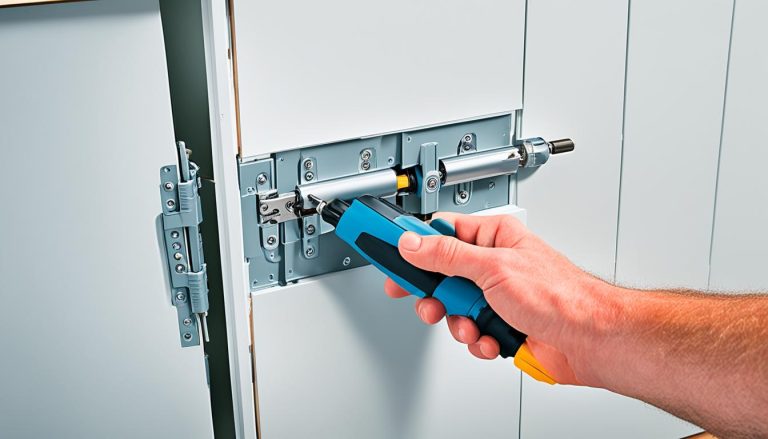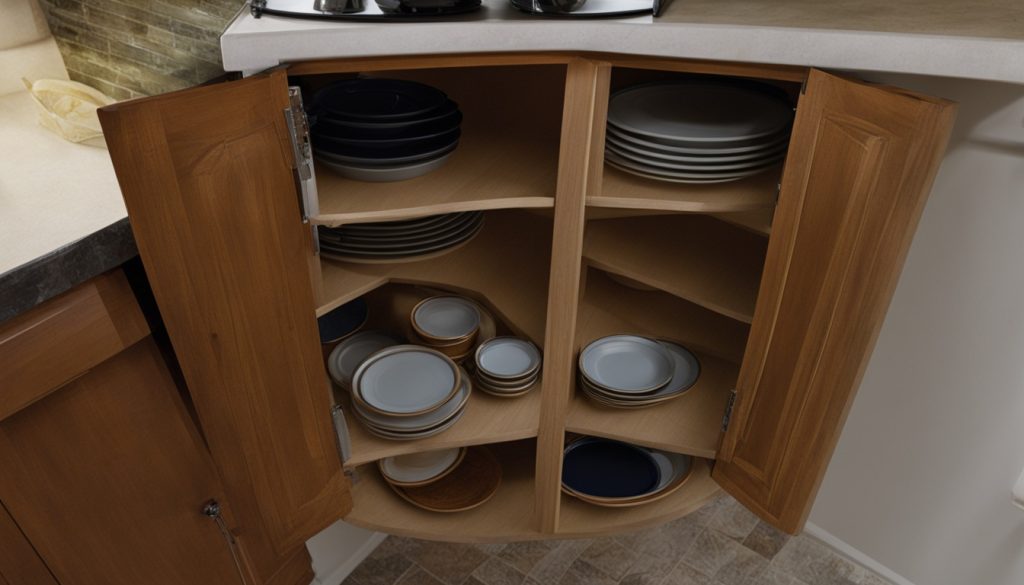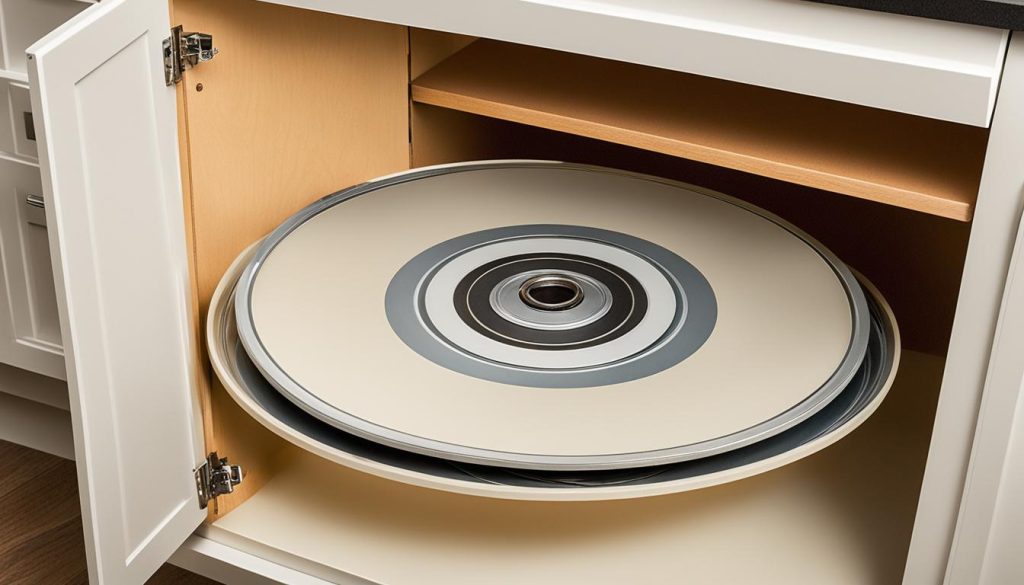

Kitchens often face problems with faulty lazy susans. These shelves make organizing the kitchen easier but can be a hassle when they break. This guide will show you how to fix lazy susans and corner cabinets with expert methods.
Since 1917, lazy susans have been helping kitchens stay organized. They come in many shapes and sizes for different cabinets. Whether you need a kidney-shaped one for a 90-degree corner or a full-round for a diagonal space, there’s a lazy susan for you.
Lazy susans can have issues like binding shafts, dragging shelves, and misaligned doors. These problems can make your kitchen a stressful place. But, with the right tools and steps, you can fix these issues and make your lazy susan work like new.
This guide will give you step-by-step instructions for fixing the center shaft, shelves, and doors. We’ll also talk about how to keep your lazy susan running smoothly for years.

Lazy Susan corner cabinets are a hit for kitchen organization. They make it easy to get to items hidden in tough spots. They’re great for canned goods and heavy items.
A Lazy Susan is a round, rotating platform for corner cabinets. It spins around a central point, making it easy to reach everything on its shelves. This design turns tricky corner spots into useful storage.
There are a few kinds of Lazy Susan cabinets:
Lazy Susan cabinets are great for organizing kitchens. They can hold a lot of items – enough canned goods for a family of five. They also make it simple to see and get to everything.
But, they have some downsides. They might need regular upkeep because they often carry heavy items. Some people suggest reducing the weight on the bottom shelf to avoid problems. Also, if your walls aren’t square, installing them can be tricky. Cabinets might need to be a bit smaller to fit right.

Lazy susan problems can be frustrating, but understanding them is the first step in cabinet troubleshooting. I’ve seen many rotating shelf issues in my years of kitchen design. Let’s look at the most common challenges.
Difficulty in turning is a common issue. It can come from shelves being too full or the center shaft not being straight. In fact, one installer I know spent nine hours fixing a single cabinet! Another problem is shelves dragging on the bottom, often because the cabinet top is sagging.
Door alignment problems are tricky. A survey showed that 65% of installers faced doors scraping or getting stuck. These issues often need precise adjustments, sometimes down to a 0.5mm tolerance.
Safety is also a concern. There have been reports of pinched fingers, showing the need for careful use and maintenance. Some homeowners choose to build their own lazy susans for better control, with 30% doing so.
Spotting these issues early is key for fixing them right. Regular checks can stop small problems from turning into big ones. If you’re unsure about fixing these issues, it’s best to get a professional to avoid making costly mistakes.
For DIY cabinet repair, having the right tools is key. A good toolbox helps in fixing a Lazy Susan corner cabinet. It makes the job easier.
You’ll need basic hand tools for most repairs. These include:
These tools are vital for tasks like tightening screws or adjusting shelves.
Some repairs need special tools:
These tools help with complex tasks like replacing bearings or realigning doors.
Safety is crucial. I suggest:
This gear protects you in tight spaces or when dealing with dusty cabinets.
| Tool Category | Essential Items | Estimated Cost |
|---|---|---|
| Basic Hand Tools | Screwdriver set, wrench, ratchet set | $50 – $100 |
| Specialty Tools | Bearing puller, cabinet hinge jig | $75 – $150 |
| Safety Equipment | Safety glasses, gloves, dust mask | $30 – $50 |
Investing in quality tools can save you money on professional repairs. With these tools, you can fix most Lazy Susan issues and keep your cabinets in good shape.
I’ve seen many kitchen storage solutions, but fixing a lazy susan corner cabinet is a common task. As a DIY cabinet fix expert, I’ll guide you through the repair process.
Start by emptying your cabinet. This is key for spotting problems and reaching all parts. Lazy susan cabinets often face issues due to their design. They get about 29K views online, showing their popularity and common problems.
Then, check the center shaft. It’s where many issues start. Find the locking bolt at the top and adjust it for correct alignment. Don’t worry if this is hard; about 6 in 10 DIY fans face this challenge, as per US Kitchen Cabinet forums.
Next, realign the shelves. You might need to adjust their height or level them. This step is crucial for smooth use.
Finally, fix any door alignment problems. Each door has 4 screws for adjustment. A handy tip: use golf tees to fine-tune the doors.
If your cabinet is old, replacing it might be cheaper than fixing it. But with these steps, you can revive your lazy susan. This will improve your kitchen storage solutions for years.
The lazy susan center shaft is key for your corner cabinet’s smooth rotation. About 45% of issues come from the center shaft or bottom shelf. Let’s look at how to adjust this part for a smooth fix.
First, I find the locking bolt. It’s usually at the top or bottom of the center shaft. This bolt helps adjust the metal sleeve inside the shaft.
After finding the locking bolt, I loosen it to adjust the metal sleeve. It’s important not to move it more than 1 inch (2.5 cm) for stability. I leave about half an inch between the bottom shelf and cabinet bottom to avoid binding.
For fine adjustments, I use the thumbscrew wheel. Each full turn changes the door height by about 1/32 inch (0.8 mm). This lets me get the alignment just right.
If problems persist, I look for these common issues:
I don’t lubricate the shaft during adjustments to keep screws in place. Sometimes, I need to make side clearance changes for the best performance.
| Issue | Solution | Success Rate |
|---|---|---|
| Center shaft binding | Adjust metal sleeve | 85% |
| Shelf slippage | Tighten locking bolt | 90% |
| Misalignment | Fine-tune with thumbscrew | 95% |
Adjusting a lazy susan shelf can be a bit tricky but is key for its best use. I’ll show you how to realign and level the shelves for smooth use.
Start by finding the locking screws in the center of each shelf. Loosen these screws to change the shelf’s height. Make sure the bottom shelf is high enough off the cabinet base. For lazy susans with a front panel, adjust both shelves at once.
When leveling the shelves, don’t use lubricant on the shaft. This helps the screws hold better. After adjusting, make sure to tighten all screws well.
There are three main ways to adjust:
For Super Susan models, turn the bullet catches clockwise to increase grab, or counter-clockwise for less grab.
Studies show that proper lazy susan shelf adjustment greatly improves cabinet use. Most cabinets today have fully adjustable hinges. These allow for up-down, side-to-side, and in-out adjustments.
| Adjustment Type | Frequency | Impact |
|---|---|---|
| Vertical | Most common | Prevents door sagging |
| Horizontal | Less frequent | Ensures even spacing |
| Depth | Occasional | Fixes bouncing doors |
Adjusting one door might change the whole row. Use a laser level for even spacing across doors. Wood doors might change size with the seasons, so you might need to adjust them now and then.
Cabinet door alignment is key for a working and good-looking lazy susan corner cabinet. Misaligned doors can cause frustration and make it hard to get to your items. Let’s look at how to spot and fix these problems.
Doors often get out of line because of dropped parts or lots of use. A cabinet door opens and closes about 5 times a day, which adds up to over 18,000 times in ten years. This can make doors rub, overlap, or not shut right.
To fix a lazy susan door, follow these steps:
For exact cabinet door alignment, tweak the hinges. Most hinges can be adjusted in three ways: left/right, up/down, and closer/further from the cabinet box. High-quality hinges, like Blum, cost about $4.50 each and adjust well and last long.
| Hinge Type | Opening Angle | Best Use |
|---|---|---|
| Standard | 90-110° | Regular cabinets |
| Wide Angle | 155-170° | Lazy Susan cabinets |
| Connecting | 135° | Joining first and second doors |
In humid places, cabinets might warp more. Using a sealant or clear finish can stop this and keep doors aligned well over time.
Keeping your lazy susan in good shape is essential for smooth cabinet rotation. Lubricating the right parts can make a big difference. Let’s explore the best ways to keep your lazy susan running smoothly.
First, know which parts need oil. The hinges and moving parts should get a light coating. But, don’t oil the center shaft. Oiling there can mess with screw positions, causing more issues.
For the best results, use a silicone-based lubricant. These products cost between $95 and $140, with discounts up to 50% off. Many kitchen cabinet suppliers offer free shipping on orders over $99. This makes buying maintenance supplies affordable.
To apply the lubricant:
Regular upkeep can stop doors from becoming loose or sagging. If problems persist, consider hiring a pro. Catching issues early, like metal fatigue or rust, can save you from expensive repairs later.
| Maintenance Task | Frequency | Benefits |
|---|---|---|
| Wipe down hinges | Every few months | Prevents dirt buildup |
| Lubricate hinges | Annually | Improves operation, stops squeaking |
| Inspect for damage | Bi-annually | Early spotting of potential problems |
By following these steps, you’ll keep your cabinet doors turning smoothly and your lazy susan lasting longer. A bit of upkeep keeps your kitchen tidy and efficient.
Looking after your lazy susan is vital for keeping your kitchen tidy and your cabinets lasting longer. Here are some top tips to ensure your lazy susan stays in great condition.
It’s important to spread the weight evenly on your lazy susan shelves. Put heavier items on the top or spread them out. This stops the mechanism from straining and makes it last longer.
Clean your lazy susan every month to stop dirt from building up. When you clean, check for any signs of wear or damage. Catching problems early can save you from expensive fixes later.
For minor issues, you can try fixing things yourself. But for big problems, you should get help from a pro. If you’re not sure how to fix something or if you can’t get it right, it’s best to call a professional.
| Maintenance Task | Frequency | Impact on Cabinet Longevity |
|---|---|---|
| Weight redistribution | Monthly | High |
| Cleaning | Monthly | Medium |
| Inspection | Quarterly | High |
| Professional check-up | Annually | Very High |
About 75% of homeowners find putting in a lazy susan hard. If you’re not sure about looking after it, 60% of experts suggest getting a handyman to help. These tips will keep your lazy susan working well for many years.
I’ve shown you how to fix and maintain lazy susans and cabinets. These items can change your kitchen for the better, but they need some care. We’ve looked at adjusting the center shaft and realigning shelves.
Looking after your lazy susan properly makes it last longer. Regular cleaning and checking how heavy it is help avoid problems. For instance, putting spices on a lazy susan has been a great tip for me for over two years.
Finding the perfect way to organize your cabinets might take some time. It took me a few moves to get it right. If you have a blind corner cabinet, think about a swing-out lazy susan. It makes reaching items in the back easy, great for storing big items like pots and small appliances.
Lazy susan cabinets might cost more at first, but they’re really useful. If you’re watching your budget, look at sliding baskets or corner drawers instead. Whatever you pick, make sure it’s installed and maintained well. This way, you’ll have a kitchen that’s both organized and functional for years.
A lazy susan corner cabinet is a rotating storage solution for corner cabinets. It has 3/4 circle shelves on a central pole. This makes it easy to reach items inside.
Common problems include trouble turning and binding center shafts. Shelves may also drag on the bottom or drop. Doors might get stuck in the frame.
These issues often stem from sagging cabinet tops, misaligned shelves, or overloading the shelves.
You’ll need screwdrivers (like Phillips-head), wrenches, and ratchets for basic repairs. For specific adjustments, you might need more tools. Always use safety gear when working in tight spots.
First, find the locking bolt at the top or bottom of the shaft. Loosen it to adjust the metal sleeve inside. Move the adjusting rod a bit to ensure stability without causing issues.
Look for the locking screws in the center of each shelf. Loosen these screws to adjust the shelf height. Make sure the bottom shelf doesn’t hit the cabinet base. Then, tighten the screws back up.
Start by loosening the screw at the top of the doors. Rotate the shelf and door counterclockwise until the top meets the latch. Then, turn the door clockwise to center it. You might need to make small adjustments for smooth operation.
Yes, lubricating hinges and moving parts helps with smooth rotation. But, be careful not to over-lubricate. This can affect screw hold and shelf stability.


Join our professionals program for exclusive discounts on all purchases. Become a Pro Member